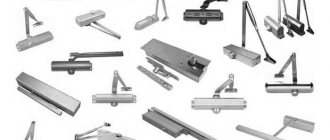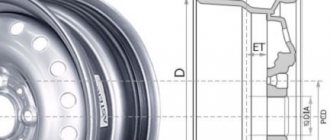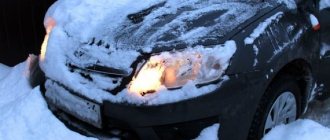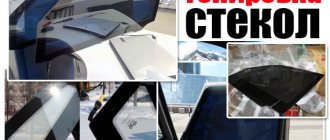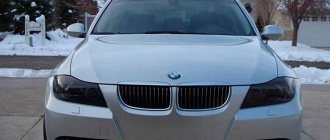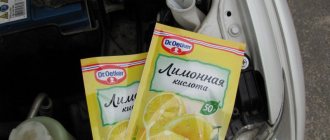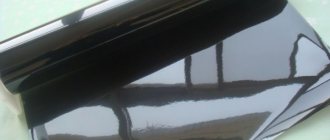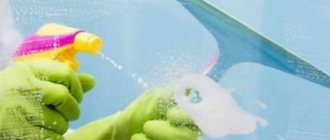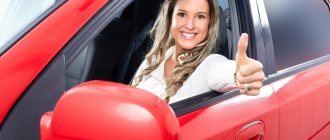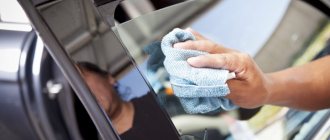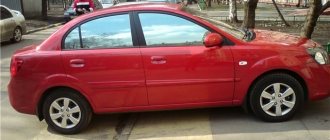Marking (rejuvenation) of auto glass
— contains complete information about the glass: characteristics, country of origin, production date, compliance with standards, etc.
Trademark, name of the plant, manufacturer;
I
— reinforced windshield;
II
- ordinary laminated windshield glass (triplex);
III
– wind-treated laminated glass (triplex);
IV
- glass made of plastic;
V
- other (not wind) glass with light transmittance below 70%;
VI
- double glass with light transmittance below 70%;
DOT 772
— manufacturer certification to US Department of Transportation standards. In this case, SAINT-GOBAIN HANGLAS SEKURIT (SHANGHAI) CO., LTD. SHANGHAI CHINA; (see full list)
M250
— manufacturer’s internal code identifying the type of glass, including color and thickness;
AS1
— compliance with the American standard, and therefore our GOST, in terms of light transmission - at least 75%.
AS2
- can be everywhere except the windshield.
AS3
- Prohibited for installation on a vehicle;
43R
— compliance with the European safety standard ECE R43;
E4
in the circle is the code of the country in which the glass was certified (but not manufactured!), in this case the Netherlands;
Country codes
:
E1
- Germany,
E2
- France,
E3
- Italy,
E4
- the Netherlands,
E5
- Sweden,
E6
- Belgium,
E7
- Hungary,
E8
- Czech Republic,
E9
- Spain,
E10
Yugoslavia,
E11
- England,
E12
- Austria,
E13
- Luxembourg,
E14
- Switzerland,
E16
- Norway,
E17
- Finland,
E18
- Denmark,
E19
- Romania
E20
- Poland,
E21
- Portugal,
E22
- Russia,
E23
- Greece,
E24
- Ireland,
E25
- Croatia,
E26
- Slovenia ,
E27
- Slovakia,
E28
- Belarus,
E29
- Estonia,
E31
- Bosnia and Herzegovina,
E32
- Latvia,
E34
- Bulgaria,
E36
- Lithuania,
E37
- Turkey,
E39
- Azerbaijan,
E42
- European Community,
E43
- Japan,
E45
- Australia,
E46
- Ukraine,
E47
- South Africa,
E48
- New Zealand,
E49
- Cyprus,
E50
- Malta,
E51
- Republic of Korea,
E52
- Malaysia,
E53
- Thailand;
TRANSPARENCY
- transparency, that is, light transmittance.
75% MIN
. means that the glass transmits at least 75% of light;
Compliant with Chinese safety standard CCC E000472;
European Certificate of Conformity number;
Automotive glass type
Laminated, Lamisafe
— laminated glass (
“triplex”
unfolded);
Tempered, Temperlite, Therlite
- tempered glass;
Decoding the glass markings for Hyundai Santa Fe
This article will help you understand and decipher all the main markings and meanings of signs and special codes on car windows. The Shenzhen Benson Automobile Glass company (Shenzhen, China) is the most popular and well-known manufacturer of auto glass for almost all brands of cars. For example, the Benson Factory uses in its production the most advanced equipment from the GDR, Italy, Switzerland and has at its disposal quality certificates such as ISO./.TS16949, ISO14001, GB9656, as well as a certificate for the sale of automotive glass and in the Russian Federation.
Car glass marking: what you need to know
- September 20, 2018
- Added by: DITS-servis
- Category: Good to know
- Tags auto glass, types of glass, how to choose, markings, original or fake, manufacturers
- 10417
Original auto glass has factory markings. If you understand how to read glass markings, you can not only protect yourself from dangerous counterfeits, but also find out the date of manufacture of the glass, country of manufacture and other important data.
The marking is applied in the lower or upper corner of the glass. It consists of the following elements:
- manufacturer's name or trademark
- type of glass
- compliance of the glass with the European standard and code of the country that carried out the certification
Let's look at each element in more detail.
At the top of the logo is the name of the glass manufacturer (brand) . If the model's logo is applied, such glass was delivered to the conveyor.
Under the brand there is usually an inscription that shows the type of glass production technology:
laminated , lamisafe - laminated triplex glass, used for windshields, sometimes for side windows
tempered , temperlite , T - tempered glass, stalinite, used only for side and rear windows
The month and year of manufacture of is indicated at the bottom of the marking . It can be written in numbers, such as 05.14 (May, 2014), or indicated by dots. In the latter case, the sum of the dots before the number indicates the month number. After the number, add another 6 to the month number.
For Chinese-made glass, the digital value under the abbreviation in the top row indicates the year of manufacture of the product, the sum of the second row of digits is the month, and the sum of the third row of digits is the number.
Under the letter M is a material code that can be used to determine the type, color and thickness of the glass.
The TINTED lettering is present on the glass with a light factory tint.
Roman numerals indicate the type of glass . On almost all windshields it is II:
- I - reinforced windshield
- II - windproof ordinary laminated glass
- III – wind treated laminated glass
- IV - plastic glass
- V – other (not wind) glass with light transmittance below 70%
- VI, VII - double glass with light transmittance below 70%
The letter E**, where instead of ** a numeric code, indicates the country that officially certified the product.
A list of country codes will help you navigate the decoding:
| E1 | Germany |
| E2 | France |
| E3 | Italy |
| E4 | Netherlands |
| E5 | Sweden |
| E6 | Belgium |
| E7 | Hungary |
| E8 | Czech |
| E9 | Spain |
| E10 | Serbia |
| E11 | England |
| E12 | Austria |
| E13 | Luxembourg |
| E14 | Switzerland |
| E16 | Norway |
| E17 | Finland |
| E18 | Denmark |
| E19 | Romania |
| E20 | Poland |
| E21 | Portugal |
| E22 | Russia |
| E23 | Greece |
| E24 | Ireland |
| E25 | Croatia |
| E26 | Slovenia |
| E27 | Slovakia |
| E28 | Belarus |
| E29 | Estonia |
| E31 | Bosnia and Herzegovina |
| E32 | Latvia |
| E37 | Türkiye |
| E42 | EU |
| E43 | Japan |
| E45 | Australia |
| E46 | Ukraine |
| E47 | South Africa |
| E48 | New Zealand |
| E49 | Cyprus |
| E50 | Malta |
| E51 | The Republic of Korea |
| E52 | Malaysia |
| E53 | Thailand |
Under the letters DOT lies the code of the plant where the glass was produced. A table of manufacturer codes will help you find detailed data.
As a rule, glass is produced in the same country where it is certified. But there are exceptions.
The remaining numbers and letters on the auto glass markings indicate compliance with production standards . Most often these are conformity marks:
- American standard AS, designated as AS1, AS2, AS3
- to the European standard ECE R43, designated 43R
- Chinese standard CCC E000199/E000039, is designated the same way or as a drawing of a circle with the letters CCC inside.
To make the best choice of automotive glass and not be mistaken with its quality, contact the professionals of DITS-service.
Why is labeling needed and what does it contain?
Glass for cars must be marked (rejuvenated). It contains information about the manufacturer, certification, date of manufacture and other parameters. Auto glass is marked according to certain rules, and they are the same for all manufacturers.
You may be interested in:Korean car batteries: review
Rejuvenation contains:
- manufacturer's name or trademark;
- standards;
- date of manufacture;
- product type;
- code of the country that granted approval.
In addition, additional parameters such as built-in heating on the rear windows or the presence of anti-reflective coating may be specified.
Glass type
Stalinite
– glass, which is used in the automotive industry for the manufacture of rear and door windows, as well as overhead hatches. It can be recognized by its marking with the letter “T” or the inscription Tempered, which means “Tempered”. Russian tempered glass for cars is designated by the letter “Z”.
Triplex
– glass, which consists of two sheets connected by a polyvinyl butyl film. The elastic organic layer creates shock-absorbing resistance of the glass to external mechanical influences. When glass breaks, its fragments do not fall out, but remain glued to the plastic layer, and therefore do not pose a threat to the driver and passenger sitting in front. Impact-resistant triplex glass is used in the automotive industry as windshield glazing.
Multilayer automotive glass
, consisting of several sheets and having more than one adhesive organic layer, are used very rarely in exclusive models of executive class cars. They create good heat and noise insulation of the car interior and can also be used in armored cash-in-transit vehicles.
Markings are also applied to the glass indicating its design features.
Acoustic inscription
or an ear-shaped pictogram - sound-absorbing glass (the film between the layers of glass has an increased noise absorption coefficient). Usually installed on diesel versions.
Solar inscription
— heat-reflecting glass. It has a metal coating on the surface, due to which 40-45% of thermal energy is reflected and dissipated.
Inscription IR
- so-called athermal glass (it is sometimes called “chameleon”). Has a characteristic purple tint. Between the layers of glass, in addition to the polyvinyl butyral film, a layer of film containing silver is added, due to which 70-75% of thermal energy is reflected and dissipated. This glass is installed on top-end configurations of German cars and many French ones.
Athermal glass with solar reflective coating.
(thermometer with a plus/minus sign and an arrow) Refers to glass that offers better thermal comfort. Glass absorbs heat better than plain tinted glass, or reflects sunlight.
Athermal glass with UV filter.
(thermometer with a plus/minus sign, an arrow and the letters UU) Glass effectively protects passengers and interior materials from solar heat and ultraviolet rays.
Athermal glass with anti-reflective coating.
The glass provides driver comfort by reducing reflection in the windshield by more than 40%. A special anti-reflective coating is applied to the inside of the windshield and significantly reduces reflection in the windshield.
Anti-vandal.
High strength glass.
Applicable labeling standards
If we talk about car glass markings, then we can distinguish 2 main standards that are used by car glass manufacturers. This is an American and European product designation standard.
- American marking. In this case, the product must comply with the FMVSS205 standard. Glass is a part that must be marked and contain all the necessary information, including confirmation of quality and safety. There are tags in the form of a monogram. They are often called beetles. Different manufacturers have their own identification method, but they all always contain the same set of information.
- European marking. European countries have their own safety standards that apply to auto glass and are implemented on their territory. Taking into account the existence of laws in different countries, a common unified standard was developed for the EU, which was approved by all representatives of the association. Their standard specifies the need for the letter E in the monogram. Some products from Europe that are sold and installed in the United States may also carry the European label.
Russia has its own standard. This is GOST 572788. In this case, the marking is presented in the form of a alphanumeric code, which contains information about the type, type of auto glass, its thickness, the film used, grade, etc.
Understanding the features of decryption is not at all difficult.
VAZ car glass markings
Previously, all Russian cars had BSZ glass installed. Now this plant is part of the AGC group of companies.
Decoding the markings of auto glass from BSZ:
- The plant's trademark is BOR
- T - tempered auto glass
- TINTED is a light green athermal glass with heat-absorbing properties.
- OVERTINTED - athermal dark green auto glass. It has increased heat-absorbing qualities.
- WL - wind multilayer (triplex).
- E2 43R 001 207 - certificate that the glass meets all requirements; the country that has issued approval is France.
- ASI M461 DOT 183 is a mark of conformity with the American standard.
- ...8 is the production date, with the dots representing the month and the number representing the year.
Auto glass manufacturers
The leader among manufacturers is Pilkington (Finland). He owns every fourth auto glass in the world. Produced under the brands Pilkington, Sicursiv, Arva, Triplex, Sigla, Nordlamex and some others.
Another leader is the French company SEKURIT SAINT-GOBAIN. It produces many different products. But the subsidiary company AUTOVER deals with automobile glass. The company produces high-quality products under the SAINT-GOBAIN SEKURIT brand. Every second European car has glass of this brand. The range includes windshields, rear windows, side windows, tinted or not, with or without additional functions.
The leader in sales on the Russian market of auto glass for foreign cars is the Polish company JAAN. The products are manufactured under the Nordglass brand. Glass meets all European standards. Manufactured from SAINT-GOBAIN SEKURIT sheet glass and Du Pont film.
The Spanish manufacturer Guardian produces mirrors, sheet and laminated windshields.
The Splintex trademark from the Glaverbel concern, which belongs to the ASAHI company, has many factories in Europe, as well as in Russia. Glass is also produced under the Lamesafe and Lamit brands.
An independent company from Hong Kong, Xinyi Group (Glass) Co, specializes exclusively in the production of auto glass and various accessories for them. The products have an optimal price-quality ratio.
The Chinese company FUYAO GLASS works in two directions: production and supply to the primary market, as well as supply of automotive glass to the secondary market. The company's products are in no way inferior in quality to products from more well-known companies.
The Bor Glass Factory (BSZ) was acquired and modernized by Splintex back in the 90s. All products strictly comply with the required standards. The plant produces auto glass in light green and darker green colors with different heat absorption properties. Currently part of the Japanese holding Asahi Glass Company (AGC).
